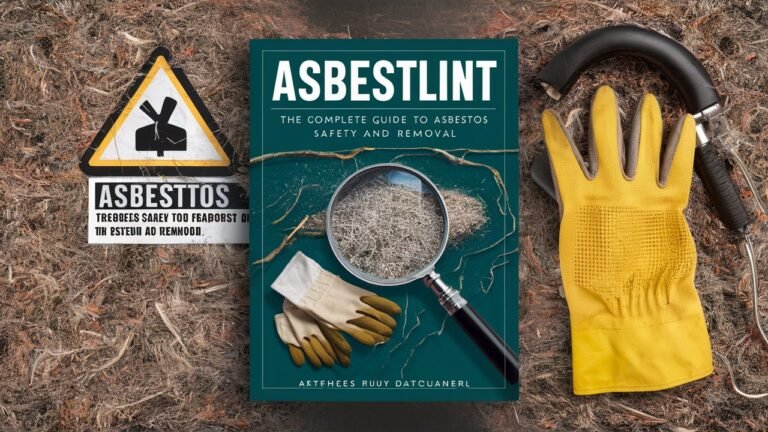Asbestlint (asbestos-containing materials) remains one of the most hazardous construction materials still found in older buildings today. Despite being banned in many countries, asbestos exposure continues to pose serious health risks, including lung cancer, mesothelioma, and asbestosis. Proper handling, identification, and removal of asbestlint are crucial for ensuring safety in homes, workplaces, and public spaces.
This comprehensive guide will explore what asbestlint is, its dangers, legal regulations, safe removal procedures, and alternatives. Additionally, we’ll answer frequently asked questions to help homeowners, contractors, and safety inspectors manage asbestos risks effectively.
What is Asbestlint?
Asbestlint refers to materials that contain asbestos fibers, commonly used in construction before the 1980s due to their heat resistance, durability, and insulating properties. These fibers, when disturbed, become airborne and can be inhaled, leading to severe respiratory diseases.
Common Materials Containing Asbestlint
-
Insulation (pipe, attic, and boiler insulation)
-
Flooring (vinyl tiles, adhesives, and backing)
-
Roofing and siding (asbestos cement sheets)
-
Textured coatings (popcorn ceilings, artex)
-
Fireproofing materials (spray-on insulation in steel structures)
Since asbestos is only dangerous when friable (easily crumbled), intact asbestlint may not pose an immediate threat. However, any renovation or demolition work can release toxic fibers into the air.
Health Risks of Asbestlint Exposure
Asbestos-related diseases often develop decades after exposure, making early prevention critical. The primary health risks include:
1. Mesothelioma
-
A rare and aggressive cancer affecting the lining of the lungs, abdomen, or heart.
-
Almost exclusively caused by asbestos exposure.
2. Lung Cancer
-
Asbestos workers who smoke have a 50 times higher risk of developing lung cancer.
3. Asbestosis
-
A chronic lung condition causing scarring and breathing difficulties.
-
Symptoms include persistent coughing and chest tightness.
4. Pleural Thickening
-
The lining of the lungs thickens, leading to reduced lung function.
Due to these severe risks, many countries have strict regulations on asbestos handling and removal.
Legal Regulations on Asbestlint
Different countries have varying laws regarding asbestos management:
1. European Union (EU)
-
Banned since 2005, but many older buildings still contain asbestos.
-
Strict removal and disposal protocols enforced by national agencies.
2. United States
-
Not fully banned; some products still contain limited asbestos.
-
EPA and OSHA regulations require proper abatement procedures.
3. Australia
-
Complete ban since 2003.
-
Mandatory licensed removalists for high-risk asbestos.
Before any demolition or renovation, asbestos surveys are legally required in most jurisdictions to identify asbestlint.
Safe Removal and Disposal of Asbestlint
Improper handling of asbestos can lead to fiber release, putting workers and residents at risk. Follow these steps for safe removal:
1. Professional Asbestos Testing
-
Hire a licensed inspector to confirm asbestos presence.
-
Lab analysis determines fiber type and concentration.
2. Hiring Licensed Abatement Contractors
-
Never attempt DIY asbestos removal—specialized training is required.
-
Contractors use negative air pressure systems, HEPA filters, and protective suits.
3. Proper Disposal Methods
-
Asbestos waste must be sealed in labeled, leak-proof containers.
-
Disposed of at approved hazardous waste facilities.
4. Post-Removal Air Monitoring
-
Ensures no residual fibers remain in the environment.
Alternatives to Asbestlint in Modern Construction
Since asbestos bans, safer alternatives have been developed, including:
-
Fiberglass insulation (non-toxic, similar thermal properties)
-
Cellulose insulation (eco-friendly, made from recycled paper)
-
Mineral wool (fire-resistant, excellent soundproofing)
-
Polyurethane foam (lightweight, high insulation value)
These materials provide similar benefits without the health risks of asbestlint.
Conclusion
Asbestlint remains a hidden danger in many older structures, requiring careful identification, professional removal, and strict regulatory compliance. Understanding the risks and proper handling procedures can prevent long-term health consequences.
If you suspect asbestos in your property, always consult a licensed professional before taking any action. Safety should always come first when dealing with hazardous materials.
FAQ: Asbestlint Safety and Removal
1. How can I tell if a material contains asbestos?
-
Visual inspection is unreliable—only lab testing can confirm asbestos presence.
2. Is it safe to live in a house with asbestos?
-
Yes, if undisturbed—asbestos is only dangerous when fibers become airborne.
3. Can I remove asbestos myself?
-
No—DIY removal is illegal in many places and extremely hazardous.
4. How much does asbestos removal cost?
-
Varies by location and project size—typically $1,500–$3,000 for residential properties.
5. What should I do if I’ve been exposed to asbestos?
-
Consult a doctor immediately—early monitoring can help detect asbestos-related diseases.
By staying informed and following safety guidelines, you can protect yourself and others from the dangers of asbestlint. 🚧⚠️
